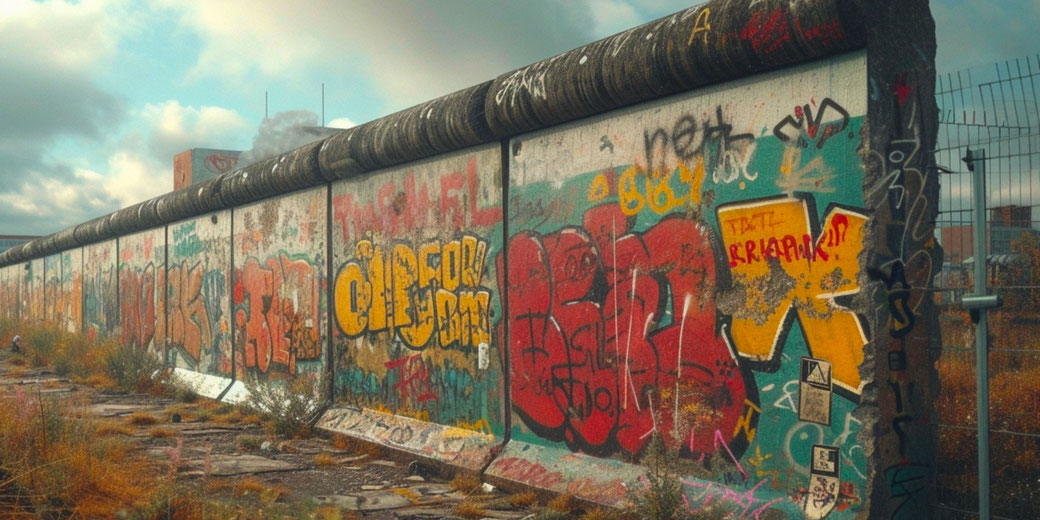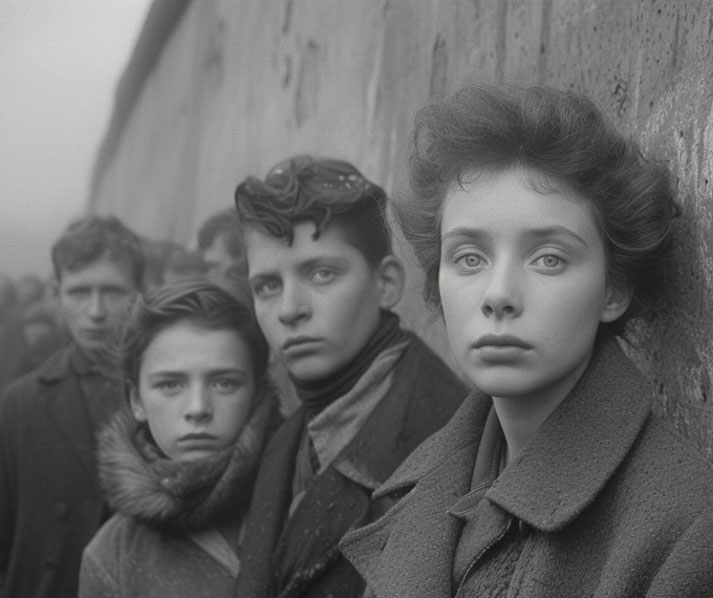Iron Curtain in concrete: Why the Berlin Wall was built

As dawn broke on August 13, 1961, the residents of Berlin awoke to a startling reality: their city was being cleaved in two by a wall of concrete and barbed wire.
The Berlin Wall, a symbol of Cold War tensions that would endure for nearly three decades, began as a surprise overnight project, transforming the cityscape and the lives of millions.
But what compelled a nation to divide its heart, to turn neighborhoods into fortresses and friends into distant strangers?
The cause of global tensions after WWII
The Cold War era began shortly after the end of World War II in 1945. This period, defined by the rivalry between the United States and the Soviet Union, saw the world divided into two distinct blocs: the Western bloc, led by the United States and its NATO allies, advocating for capitalism and democracy, and the Eastern bloc, led by the Soviet Union, promoting communism and a centrally planned economy.
The Potsdam Conference in July 1945, attended by the major Allied powers, sought post-war reorganization, but also sowed the seeds of division, particularly in Germany and its capital, Berlin.
Germany, defeated and in ruins, was partitioned into four zones of occupation by the victorious powers: the United States, the Soviet Union, Britain, and France.
Berlin, despite being deep within the Soviet zone, was similarly divided.
This division of Germany became a microcosm of the Cold War, with the contrasting ideologies of the occupiers becoming increasingly apparent.
In June 1948, the Soviets, aiming to assert control over the whole of Berlin, initiated the Berlin Blockade, cutting off all land access to West Berlin.
In response, the Western Allies launched the Berlin Airlift, a monumental effort that lasted until May 1949, supplying West Berlin with vital necessities via air.
What was happening in Berlin before the wall?
Following the end of World War II, the victorious Allies partitioned Berlin into four sectors, mirroring the division of Germany itself.
The Western sectors, controlled by the United States, Britain, and France, developed along capitalist lines, while the Eastern sector, under Soviet control, adhered to the principles of a socialist state.
This division of Berlin into East and West became more than just a geographical split; it was a vivid representation of the ideological rift between the Western powers and the Soviet Union.
Life in the two halves of Berlin grew increasingly disparate in the years following the war.
West Berlin, though an island within communist East Germany, prospered under the Marshall Plan, which saw significant economic aid flow from the United States.
This part of the city became a vibrant hub of Western culture and capitalism, a showcase of recovery and prosperity.
In contrast, East Berlin, adhering to the Soviet model, experienced economic hardships and a more austere way of life.
The standard of living and the degree of political freedom differed markedly between the two halves of the city.
This stark contrast led to a significant movement of people from East to West Berlin.
Many East Berliners, disillusioned with life under a communist regime and attracted by the opportunities in the West, started leaving the Eastern sector in droves.
By the early 1960s, it is estimated that thousands of East Germans were defecting to the West every day, a trend that severely depleted the workforce and threatened the viability of the East German state.
The flow of refugees was a propaganda disaster for the Soviet Union and its socialist model.
Each person crossing from East to West Berlin represented a tacit rejection of the communist system, further widening the ideological chasm between the superpowers.
The Soviet Union, under Nikita Khrushchev, and the East German leadership, under Walter Ulbricht, grew increasingly concerned about this exodus and its implications for the stability and legitimacy of the Eastern Bloc.

How the idea of the Berlin Wall was conceived
By the early 1960s, it was estimated that nearly 20% of the East German population had fled to the West, a migration that included a disproportionately large number of young, educated professionals.
This brain drain threatened not only the economic stability of the GDR but also its ideological legitimacy.
Walter Ulbricht, the leader of the GDR, pressured by the deteriorating situation and the growing discontent among the populace, sought a radical solution to stem the tide of emigration.
Despite initial reluctance from Soviet leader Nikita Khrushchev, Ulbricht received approval for the construction of a barrier after convincing him of its necessity.
The justification provided was twofold: it was a defensive measure against what they portrayed as Western aggression and a means to prevent the destabilization of the socialist state in the East.
How the Berlin Wall was built
On the night of August 12-13, 1961, Berliners were taken by surprise when East German troops, police forces, and construction workers began erecting barbed wire and concrete barriers across the city.
Roads were torn up, and barricades were erected overnight, cutting through streets, neighborhoods, and even buildings, leaving families and communities suddenly and shockingly divided.
The rapidity and stealth with which the Wall was erected left both the residents of Berlin and the international community stunned.
This initial barrier, rudimentary yet effective, was the precursor to a more elaborate and formidable structure that would come to define the city for decades.
Over the following weeks and months, the temporary barbed wire fencing was gradually replaced with a more permanent structure.
By August 15, a concrete wall, reinforced with mesh fencing and topped with barbed wire, began to take shape.
The construction was rapid and efficient, with East German authorities mobilizing all available resources to ensure the Wall’s swift rise.
By the end of August, a rudimentary wall, approximately 96 miles long, encircled West Berlin, effectively cutting it off from the surrounding East German territory.
The Berlin Wall underwent several modifications and reinforcements over the years.
Initially, it was primarily a wire fence with concrete posts. However, by 1965, a third-generation wall was constructed, featuring concrete slabs between steel girder and concrete posts.
This version of the Wall was more robust and difficult to breach. The fourth and final version, built from 1975 onwards, was the most sophisticated and daunting.
It consisted of 12-foot-tall and 4-foot-wide reinforced concrete slabs, known as "Grenzmauer 75".
This version also included smooth pipe at the top to make climbing more difficult, and the "death strip" was expanded and filled with obstacles and traps to hinder escape attempts.
Surveillance systems and anti-vehicle trenches were added, along with over 300 watchtowers manned by guards ordered to prevent escapes by any means necessary, including using lethal force.
The Wall was patrolled by soldiers and guard dogs, making any attempt to cross it extremely perilous.
The death strip, a no-man’s land between the inner and outer walls, was riddled with landmines and barbed wire, and it became a deadly trap for those daring to escape.
The impact the wall had on the people of Berlin
Life in Berlin during the years of the Wall's existence was a study in stark contrasts and shared struggles, shaped profoundly by the physical and ideological divide.
In West Berlin, a vibrant and prosperous city emerged, buoyed by economic aid from the West and the freedoms characteristic of a democratic society.
The city became a cultural hub, attracting artists, intellectuals, and young people.
It was a beacon of Western lifestyle, replete with consumer goods, colorful advertisements, and a bustling nightlife.
Despite its prosperity, West Berlin was also a city on edge, a frontier of the Cold War, constantly aware of its isolation and the ever-present threat from the East.
In East Berlin, the atmosphere was markedly different. The city was the capital of the German Democratic Republic (GDR), a state that espoused socialist ideals but was marked by authoritarian rule and economic challenges.
The standard of living was lower than in the West, consumer goods were scarce, and the state's surveillance apparatus, spearheaded by the Stasi (the Ministry for State Security), permeated every aspect of life.
The Stasi maintained a vast network of informants and conducted widespread surveillance to quash dissent and maintain control over the population.
This created an environment of distrust and fear among citizens, where speaking out against the government could have severe consequences.
The division of the city impacted families and communities deeply.
Overnight, people found themselves cut off from family members, friends, and loved ones.
Simple activities, like visiting relatives or commuting to work, became fraught with difficulties and, in many cases, impossible.
The Wall tore apart the fabric of everyday life, turning neighbors into distant figures and familiar streets into inaccessible territories.
Crossing from East to West Berlin was dangerous and difficult, particularly before the easing of travel restrictions in the late 1970s and 1980s.
Those caught attempting to flee to the West faced harsh penalties, including imprisonment and, in some cases, loss of life.
Despite these dangers, many tried to escape, driven by the desire for freedom and a better life.
These escape attempts were often dramatic and harrowing, involving tunnels, hot air balloons, and even modified cars to breach the Wall’s defenses.
For the youth in East Berlin, the Wall represented not only a physical barrier but also a limitation on their aspirations and dreams.
Western music and culture, though officially frowned upon, were highly coveted and became symbols of resistance and rebellion against the regime.
In West Berlin, young people engaged in political activism, often expressing solidarity with their counterparts in the East and protesting against the division.

How the world reacted to the Berlin Wall
Globally, the Wall was met with a chorus of denunciation. Western leaders, particularly those from the United States, the United Kingdom, and France, condemned the construction as an act of aggression and a blatant violation of human rights.
President John F. Kennedy, in a public statement, criticized the Wall as a symbol of communist tyranny.
However, despite the strong rhetoric, the Western response was largely limited to verbal condemnation.
There was a palpable reluctance to engage in any action that might escalate tensions with the Soviet Union and potentially lead to a military confrontation.
In the broader international arena, reactions were mixed. While allies of the United States generally supported its position, other countries, particularly those aligned with or sympathetic to the Soviet Union, viewed the Wall as a legitimate protective measure against Western interference.
The division of opinion over the Berlin Wall was indicative of the polarized world order of the time, with countries aligning their responses according to their ideological affiliations in the Cold War.
Within Germany, the responses were deeply emotional and complex. For many East Germans, the Wall represented a profound loss of freedom and a grim reality of their government's repressive nature.
It was a physical barrier that not only restricted their movement but also symbolized the broader constraints on their political and personal freedoms.
The Wall also served as a constant reminder of the separation from family members and friends in the West, reinforcing feelings of isolation and helplessness.
What do you need help with?
Download ready-to-use digital learning resources
Copyright © History Skills 2014-2024.
Contact via email
With the exception of links to external sites, some historical sources and extracts from specific publications, all content on this website is copyrighted by History Skills. This content may not be copied, republished or redistributed without written permission from the website creator. Please use the Contact page to obtain relevant permission.





